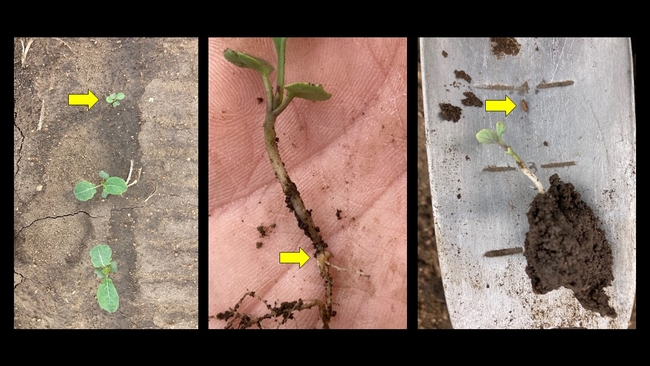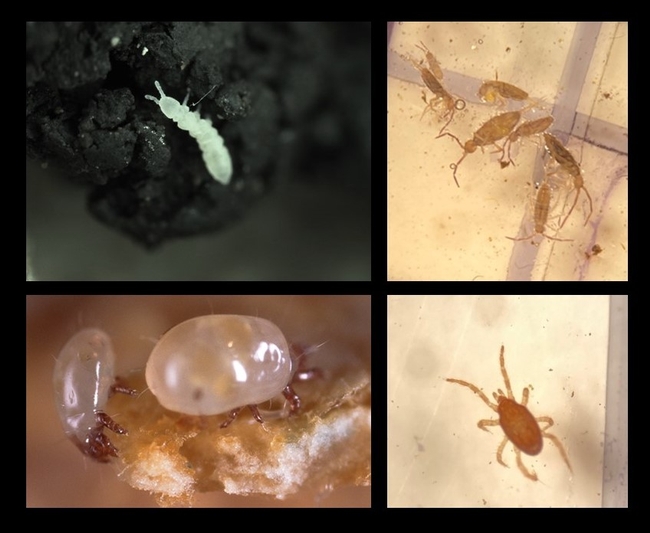I have received a handful of calls this season with concerns about “trash bugs,” a catch all term for various soil invertebrates. These soil invertebrates include root maggots, springtails, bulb mites, and symphylans, all which will happily feed on decomposing plant debris, i.e., trash. If given the opportunity, trash bugs will feed on seedlings and transplants, but high pressure can usually be avoided by allowing plant debris to fully breakdown before planting the next crop. A long enough pause between plant debris and seedlings acts as a sort of field-level host-free period, allowing trash bug populations to drop before planting.
Why does it feel like we have more trash bugs this season?
We had an unseasonably cool, wet spring. Under these conditions, crop debris from the fall was breaking down much slower than usual. With the compressed start to the season, folks have been eager to plant into fields as soon as possible, so many were likely planting into fields with higher-than-optimal plant debris.
By mid-April, daily temperatures were starting to get more back to normal, so why are we still dealing with more trash bugs? From talking with a handful of growers and PCAs, the slow start to the season has set back the whole planting schedule. To try and bring things back to schedule as close as possible, folks are still pushing the limit on how quickly they turn around fields for the next crop. A perfect storm for trash bug pressure.
Which trash bug am I dealing with?
A diverse group of pests can cause stunting and stand loss, so accurate pest ID is critical for successful management.
Root Maggots (seedcorn maggots or cabbage maggots, Delia spp.)
Root maggots are the larvae of small grey flies. The adult flies are commonly caught on sticky cards that are deployed for monitoring thrips and aphids.
Seedcorn maggot, Delia platura, seems to be the primary culprit that I have come across that is stunting brassicas. Seedcorn maggots tend to hit fields within a week or two after planting, causing patchy stands and stunted seedlings. Closely related cabbage maggots tend to hit fields a few weeks after planting and can continue to cause damage as plants mature.
To scout for root maggots, pull up stunted plants (see picture #1 below) and check roots for small, yellowish-white maggots (less than ¼ of an inch long). They can be easy to miss when they're all tangled up in the roots (picture #2). If scouting is delayed, you may also find the brown pupa (picture #3). With seedcorn maggots, timing a reactive control (i.e., insecticide application) can be tricky since the damage may go unnoticed until the maggots have already pupated and left the field.
|
From left to right: #1 broccoli stunting caused by root maggot feeding; #2 maggot tangled up in the roots of a broccoli plant; #3 root maggot pupa found next to a stunted broccoli plant. |
Springtails and soil mites
Pest springtails and soil mites are trickier to identify, since non-pest species are common in healthy soils. The one species of springtail that has been identified as an occasional pest of lettuce and brassicas is Protaphorura fimata, while the main pest mites are bulb mites (Rhizoglyphus spp., Tyrophagus spp.). Both P. fimata and bulb mites are small and whiteish while non-pest species are often larger and more colorful.
|
Clockwise from top left; Protaphorura fimata, the springtail species that can be a pest (Photo Credit: Shimat Joseph, previous UC IPM Advisor); non-pest springtails (note that these springtails are more colorful and have long antennae); a predatory soil mite (not a pest); and two bulb mites (Photo Credit: Jack Kelly Clark, UC IPM). |
Symphylans
Symphylans look like small (less than ½ an inch), white centipedes. Since symphylans are fast and mobile, you will be more likely to catch symphylans in action if you dig around stunted plants that are near healthy looking plants. If you readily find symphylans just by digging, the symphylan pressure is probably high enough to cause economic damage.
Lower symphylan densities can be harder to observe, so you may want to try bait-trapping with potato or beet wedges if you suspect symphylans but cannot find any by digging around stunted plants. The bait-trapping method can also be used to scout for springtails.
For more on the identification, scouting, and management of these pests, be sure to reference the UC IPM Pest Management Guidelines:
https://ipm.ucanr.edu/agriculture/cole-crops/
https://ipm.ucanr.edu/agriculture/lettuce/
Related blog posts from past entomology advisors:
Root maggots:
https://ucanr.edu/blogs/blogcore/postdetail.cfm?postnum=9804
https://ucanr.edu/blogs/blogcore/postdetail.cfm?postnum=4301
Symphylans:
https://ucanr.edu/blogs/blogcore/postdetail.cfm?postnum=18819
Springtails:
https://ucanr.edu/blogs/blogcore/postdetail.cfm?postnum=16769
Bulb Mites:
https://ucanr.edu/blogs/blogcore/postdetail.cfm?postnum=13271

